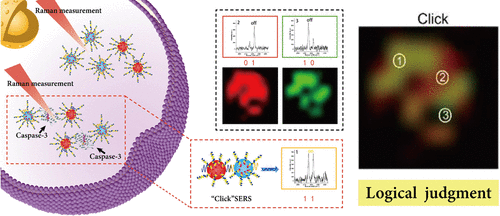当前位置:
X-MOL 学术
›
Anal. Chem.
›
论文详情
Our official English website, www.x-mol.net, welcomes your
feedback! (Note: you will need to create a separate account there.)
Promoted “Click” SERS Detection for Precise Intracellular Imaging of Caspase-3
Analytical Chemistry ( IF 6.7 ) Pub Date : 2021-03-04 , DOI: 10.1021/acs.analchem.0c04997 Wei Zhu 1, 2 , Chun-Yang Wang 1 , Ji-Ming Hu 1 , Ai-Guo Shen 2
Analytical Chemistry ( IF 6.7 ) Pub Date : 2021-03-04 , DOI: 10.1021/acs.analchem.0c04997 Wei Zhu 1, 2 , Chun-Yang Wang 1 , Ji-Ming Hu 1 , Ai-Guo Shen 2
Affiliation

|
Although homogeneous detection of some biomolecules has been of great significance in clinical assay, it faces great challenges in achieving precise in situ imaging of biomolecules. In addition, nonspecific adsorption between probes and biomolecules and low sensitivity are still unfathomed problems. Herein, we developed a promoted “Click” surface enhanced Raman scattering (SERS) strategy for realizing highly selective homogeneous detection of biomolecules by simultaneous dual enhanced SERS emissions, obtaining mutually confirmed logical judgment. Taking caspase-3 as one of the biotargets, we have realized highly selective homogeneous detection of caspase-3 using this strategy, and precise intracellular imaging of caspase-3 can be in situ monitored in living cells or during cell apoptosis. In detail, polyA-DNA and the Asp-Glu-Val-Asp (DEVD)-containing peptide sequence were modified into alkyne and nitrile-coded Au nanoparticles (NPs). During the cell apoptosis process, the generated caspase-3 would lead to the cleavage of the tetra-peptide sequence DEVD, thereby removing the negative protection part from the peptide on Au NPs. Interestingly, two different triple bond-labeled Au NPs can be connected together through DNA hybridization to form SERS “hotspot”, resulting in simultaneously enlarged triple bond Raman signals. Moreover, we found that the SERS intensity was positively related with caspase-3 concentration, which has a wide linear range (0.1 ng/mL to 10 μg/mL) and low detection limit (7.18 × 10–2 ng/mL). Remarkably, these simultaneously enlarged signals by “Click” SERS could be used for more precise imaging of caspase-3, providing mutually confirmed logical judgment based on two spliced SERS emissions, especially for their relative intensity.
中文翻译:

促进“点击” SERS检测以实现Caspase-3的精确细胞内成像
尽管某些生物分子的均相检测在临床测定中具有重要意义,但在实现生物分子的精确原位成像方面仍面临巨大挑战。另外,探针与生物分子之间的非特异性吸附和低灵敏度仍然是无法解决的问题。本文中,我们开发了一种推广的“点击”表面增强拉曼散射(SERS)策略,用于通过同时双重增强SERS排放实现生物分子的高选择性均质检测,从而获得相互确认的逻辑判断。以caspase-3作为生物靶标之一,我们已经实现了使用该策略对caspase-3的高度选择性均质检测,并且caspase-3的精确细胞内成像可以在原位进行在活细胞中或细胞凋亡期间进行监测。详细地,将polyA-DNA和含Asp-Glu-Val-Asp(DEVD)的肽序列修饰为炔烃和腈编码的Au纳米颗粒(NP)。在细胞凋亡过程中,生成的caspase-3将导致四肽序列DEVD裂解,从而从金NP上的肽中去除负保护部分。有趣的是,可以通过DNA杂交将两个不同的三键标记的Au NP连接在一起,形成SERS“热点”,从而同时放大三键拉曼信号。此外,我们发现SERS强度与caspase-3浓度呈正相关,caspase-3浓度线性范围宽(0.1 ng / mL至10μg/ mL),检出限低(7.18×10 –2)ng / mL)。值得注意的是,这些通过“ Click” SERS同时放大的信号可用于caspase-3的更精确成像,基于两个拼接的SERS发射,尤其是它们的相对强度,可以提供相互确认的逻辑判断。
更新日期:2021-03-23
中文翻译:

促进“点击” SERS检测以实现Caspase-3的精确细胞内成像
尽管某些生物分子的均相检测在临床测定中具有重要意义,但在实现生物分子的精确原位成像方面仍面临巨大挑战。另外,探针与生物分子之间的非特异性吸附和低灵敏度仍然是无法解决的问题。本文中,我们开发了一种推广的“点击”表面增强拉曼散射(SERS)策略,用于通过同时双重增强SERS排放实现生物分子的高选择性均质检测,从而获得相互确认的逻辑判断。以caspase-3作为生物靶标之一,我们已经实现了使用该策略对caspase-3的高度选择性均质检测,并且caspase-3的精确细胞内成像可以在原位进行在活细胞中或细胞凋亡期间进行监测。详细地,将polyA-DNA和含Asp-Glu-Val-Asp(DEVD)的肽序列修饰为炔烃和腈编码的Au纳米颗粒(NP)。在细胞凋亡过程中,生成的caspase-3将导致四肽序列DEVD裂解,从而从金NP上的肽中去除负保护部分。有趣的是,可以通过DNA杂交将两个不同的三键标记的Au NP连接在一起,形成SERS“热点”,从而同时放大三键拉曼信号。此外,我们发现SERS强度与caspase-3浓度呈正相关,caspase-3浓度线性范围宽(0.1 ng / mL至10μg/ mL),检出限低(7.18×10 –2)ng / mL)。值得注意的是,这些通过“ Click” SERS同时放大的信号可用于caspase-3的更精确成像,基于两个拼接的SERS发射,尤其是它们的相对强度,可以提供相互确认的逻辑判断。











































 京公网安备 11010802027423号
京公网安备 11010802027423号